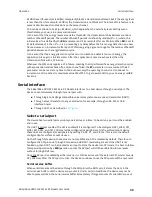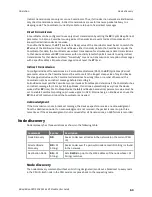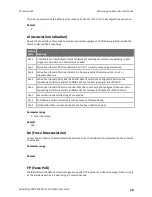
Operation
Node discovery
XBee/XBee-PRO S2C 802.15.4 RF Module User Guide
63
Indirect transmissions can only occur on a Coordinator. Thus, if all nodes in a network are End Devices,
only direct transmissions occurs. Indirect transmissions are useful to ensure packet delivery to a
sleeping node. The Coordinator currently is able to retain up to five indirect messages.
Direct transmission
A Coordinator can be configured to use only direct transmission by setting the
SP
(Cyclic Sleep Period)
parameter to 0. Also, a Coordinator using indirect transmissions reverts to direct transmission if it
knows the destination device is awake.
To enable this behavior, the
ST
(Time before Sleep) value of the Coordinator must be set to match the
ST
value of the End Device. Once the End Device either transmits data to the Coordinator or polls the
Coordinator for data, the Coordinator uses direct transmission for all subsequent data transmissions
to that device address until
ST
time occurs with no activity (at which point it reverts to using indirect
transmissions for that device address). "No activity" means no transmission or reception of messages
with a specific address. Broadcast messages do not reset the
ST
timer.
Indirect transmission
To configure Indirect Transmissions in a Personal Area Network (PAN), the
SP
(Cyclic Sleep Period)
parameter value on the Coordinator must be set to match the longest sleep value of any End Device.
The sleep period value on the Coordinator determines how long (time or number of beacons) the
Coordinator retains an indirect message before discarding it.
An End Device must poll the Coordinator once it wakes from Sleep to determine if the Coordinator has
an indirect message for it. For Cyclic Sleep Modes, this is done automatically every time the device
wakes (after
SP
time). For Pin Sleep Modes, the
A1
(End Device Association) parameter value must be
set to enable Coordinator polling on pin wake-up (set in bit 3). Alternatively, an End Device can use the
FP
(Force Poll) command to poll the Coordinator as needed.
Acknowledgment
If the transmission is not a broadcast message, the device expects to receive an acknowledgment
from the destination node. If an acknowledgment is not received, the packet is resent up to three
more times. If the acknowledgment is not received after all transmissions, an ACK failure is recorded.
Node discovery
Node discovery has three variations as shown in the following table:
Commands
Syntax
Description
Node Discovery
ND
Seeks to discover all nodes in the network (on the current PAN
ID).
Directed Node
Discovery
ND
<NI
String>
Seeks to discover if a particular node named <NI String> is found
in the network.
Destination Node
DN
<NI
String>
Sets
DH
/
DL
to point to the MAC address of the node whose <NI
String> matches.
Node discovery
The node discovery command (without an NI string designated) sends out a broadcast to every node
in the PAN ID. Each node in the PAN sends a response back to the requesting node.
















































